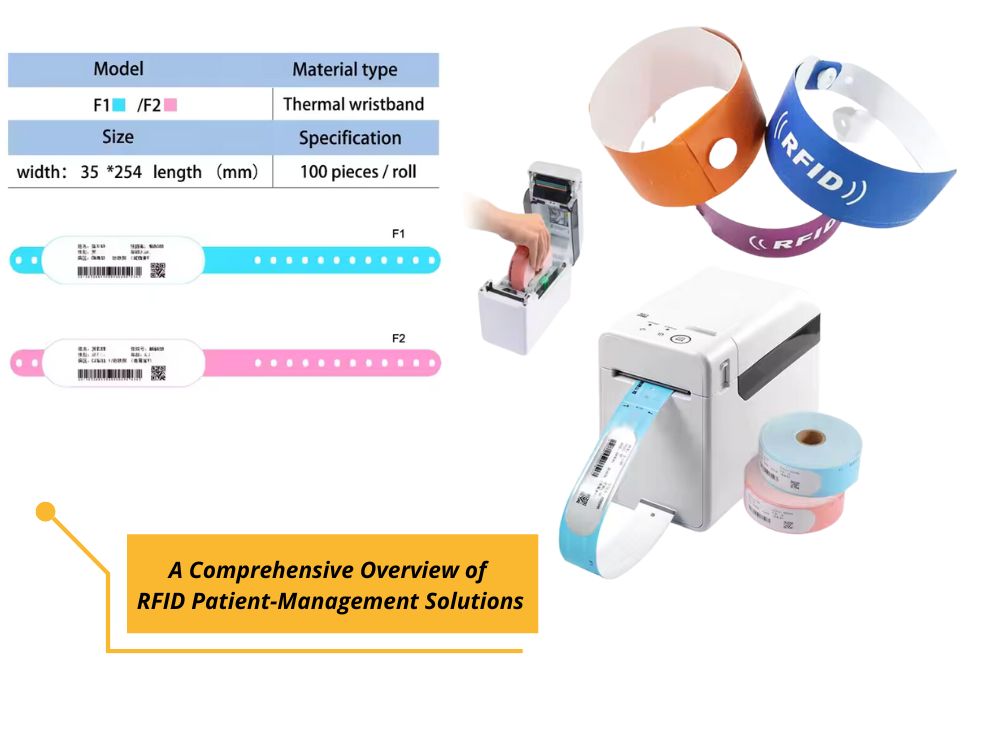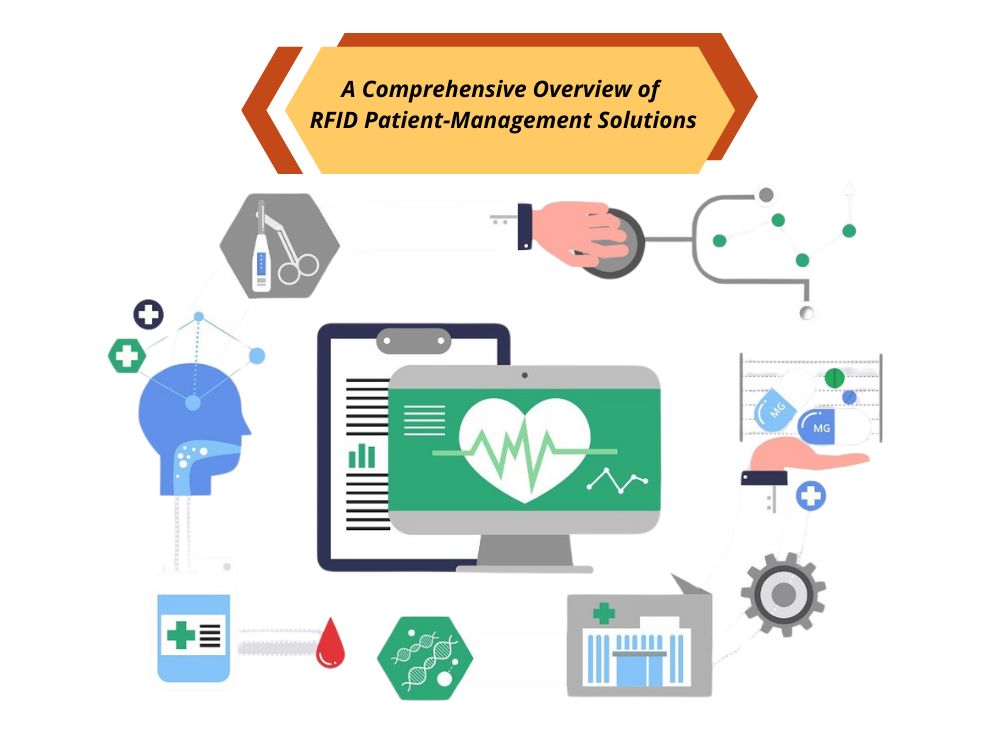
A Comprehensive Overview of RFID Patient Management Solutions
Table of Contents
Summary
These systems, which often integrate real-time location systems (RTLS), track patients from their arrival through their stay and discharge. This technology enables healthcare providers to streamline operations, reduce wait times, and improve patient outcomes.

Evolution of RFID in Healthcare
Healthcare facilities, such as Texas Health Harris Methodist Hospital Alliance and Joint Implant Surgeons of Florida, have successfully deployed patient-management RTLS. These systems allow hospitals to automate discharge processes, track patients, and improve overall efficiency. Moreover, the technology supports monitoring healthcare workers to ensure patient safety, reduce response times, and even aid in emergency situations through features like duress alarms.
Key Benefits of RFID Patient Management Solutions
RFID solutions are not just about tracking patients; they enhance safety and security across various healthcare settings. For example, they can monitor patients prone to wandering, such as those with dementia. These systems also notify staff when a patient is ready to return to their room after tests or when operating rooms become available, facilitating smoother transitions and better resource utilization.
Deployment Strategies and Technologies
Deploying RFID patient-management RTLS can be tailored to specific healthcare needs. Options range from standalone systems to comprehensive solutions integrating asset tracking and patient monitoring. Solutions like CenTrak and Sanitag offer versatile deployment modules, allowing hospitals to focus on particular areas such as neonatal care or expand coverage across the entire facility.
Customizing RFID Solutions
The flexibility of RFID solutions allows healthcare facilities to customize deployment based on their needs. For instance, CenTrak offers solutions that integrate with existing systems, enhancing their value by adding patient tracking and hand-hygiene compliance monitoring. Similarly, Sanitag provides modular platforms that can be scaled as required, while SecuriCode’s solutions offer detailed tracking capabilities at various levels, including room and bed-level accuracy.
Technical Aspects and Location Accuracy
The technical backbone of these systems often combines active RFID tags with infrared (IR) technology to achieve precise location accuracy. This combination allows for long-range tracking and room-level precision. Wi-Fi-based RTLS is commonly employed, reducing installation time and costs while ensuring seamless data transmission across healthcare networks.

Enhancing Location Precision
While active RFID tags offer extensive range, technologies such as IR beacons and RF exciters provide enhanced accuracy, down to bed-level precision. For example, CenTrak’s Gen 2 IR devices offer room and bed-level accuracy, crucial for optimizing clinical workflows and improving patient care.
Integrating Business Intelligence
RFID patient-management solutions go beyond tracking; they incorporate business intelligence tools to analyze patient flow, staff efficiency, and overall hospital operations. Software platforms such as Ekahau’s Vision and SecuriCode’s Atlas provide customizable reports, enabling healthcare administrators to identify operational bottlenecks and improve service delivery.
Data-Driven Decision Making
The integration of data analytics within RFID solutions allows healthcare facilities to make informed decisions, improving both patient satisfaction and operational efficiency. Features like Forensic Replay enable administrators to review incidents and enhance emergency response protocols.
The Future of Patient Management
As healthcare systems increasingly prioritize patient satisfaction, RFID-based patient-management solutions are poised for widespread adoption. These technologies not only improve patient care but also contribute to better Hospital Consumer Assessment of Healthcare Providers and Systems (HCAHPS) scores, directly impacting healthcare reimbursement.
Expanding RFID Applications
Beyond traditional patient tracking, future applications of RFID in healthcare may include automated billing, real-time resource allocation, and enhanced patient experience. With ongoing advancements, RFID technology will continue to play a critical role in elevating the standards of healthcare delivery.
Key Features of Leading RFID Patient-Management Solutions
Feature | CenTrak | Sanitag | SecuriCode | Ekahau |
Deployment Options | Standalone or Integrated | Modular Deployment | Standalone or Integrated | Standalone or Integrated |
Location Accuracy | Bed-Level (Gen 2 IR) | Room-Level (Wi-Fi) | Room/Zone-Level | Room/Zone-Level (IR Beacons) |
Business Intelligence | Partner End-User Software | Executive Dashboards | Customizable Reports | Vision Software (Customizable) |
Emergency Features | Duress Alarms, Workflow Alerts | Nurse Call System | Incident Monitoring | Forensic Replay, Dwell Time |
Integration | EMR Integration | Asset & Staff Management | Asset Tracking | Asset & Temperature Monitoring |
Conclusion
RFID patient-management solutions are revolutionizing healthcare by enhancing patient care, improving operational efficiency, and providing critical data insights. As healthcare facilities continue to adopt these technologies, the future of patient care looks more efficient, safe, and patient-centric than ever.
Comments
Hot Products

What Is RFID Waste Management
Imagine a city where every trash bin speaks — not literally — but through a tiny chip that tells the system when it’s full, when it’s emptied, and where it went. That’s what RFID waste management is doing today.

What are Bolt Seals and their Applications? | Complete Guide
In global trade and logistics, bolt seals play a crucial role in ensuring cargo security and compliance. These small but powerful devices are designed to lock shipping containers, trailers, and cargo doors with a tamper-evident mechanism.

What is an RFID Card Protector? Benefits, Use Cases, and Buying Guide
RFID technology (Radio Frequency Identification) is everywhere: in your credit cards, ID badges, transit passes, hotel room keys, and more. It offers speed and convenience, but it also opens the door to a new kind of digital theft called “skimming.” That’s where an RFID card protector comes in.

RFID Wristbands for Events: Bulk Buying Guide for Organizers
RFID wristbands for events are becoming the go-to solution for organizers who need faster entry, fraud prevention, and cashless payments at concerts, festivals, and sports venues. Unlike paper tickets or QR codes, these smart wristbands use embedded chips to streamline access, secure transactions, and improve the guest experience.

How RFID Tag on Windscreen Improves Vehicle Access Control and Toll Systems
In today’s fast-paced world, vehicle identification needs to be quick, secure, and contactless. An RFID Tag on the Windscreen provides exactly that — a reliable way to manage toll collection, parking, and gated access without stopping vehicles.

The Benefits of RFID Linen Tags in Commercial Laundry
Managing laundry in hospitals, hotels, or large laundry services is a big job. Each day, thousands of sheets, towels, and uniforms are washed, sorted, and sent back out. But problems like lost linens, sorting mistakes, and manual counting can cost companies a lot of money. For example, mid-sized hotels can lose over $200,000 each year from missing linens.
That’s where RFID Linen Tags come in.
Tags
RELATED BLOGS

What Is RFID Waste Management
Imagine a city where every trash bin speaks — not literally — but through a tiny chip that tells the system when it’s full, when it’s emptied, and where it went. That’s what RFID waste management is doing today.

What are Bolt Seals and their Applications? | Complete Guide
In global trade and logistics, bolt seals play a crucial role in ensuring cargo security and compliance. These small but powerful devices are designed to lock shipping containers, trailers, and cargo doors with a tamper-evident mechanism.

What is an RFID Card Protector? Benefits, Use Cases, and Buying Guide
RFID technology (Radio Frequency Identification) is everywhere: in your credit cards, ID badges, transit passes, hotel room keys, and more. It offers speed and convenience, but it also opens the door to a new kind of digital theft called “skimming.” That’s where an RFID card protector comes in.




